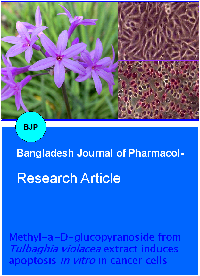Methyl-α-D-glucopyranoside from Tulbaghia violacea extract induces apoptosis in vitro in cancer cells
DOI:
https://doi.org/10.3329/bjp.v8i2.13717Keywords:
Apoptosis, activity-guided fractionation, anti-cancer, methyl-a-D-glucopyranoside, Tulbaghia violaceaAbstract
Pro-apoptotic activity of Tulbghia violacea extracts was evaluated in order to understand the mechanisms of action that might be related to its traditional use as anticancer medicine. Apoptosis-guided purification was used to isolate active compound whose chemical structure was solved by using spectros-copic, microanalysis and X-ray crystallography techniques. T. violacea extract kills Chinese hamster ovary cells, MCF7, and HeLa cells through the induction of apoptosis Methyl-a-D-glucopyranoside was identified as one of the main pro-apoptotic compounds present in T. violacea extract. This is the first time ever demonstration that T. violacea contains methyl-a-D-glucopyranoside, which selectively kills cancer cells through apoptosis mechanisms.
Downloads
416
196 Read
19
References
Allsop TE, Wyatt S, Paterson HF, Davies AM. The photo-oncogene bcl-2 can selectivity rescue neurotrophic factor-dependant neurons from apoptosis. Cell 1993; 73: 293-307.
Berman HM, Kim SH. The crystal structure of methyl-a-D-glucopyranoside. Acta Cryst B. 1968; 24: 897-904.
Biocolor. APOPercentage manual. 3rd ed. Newtownabbey, Northern Ireland, Biocolor Ltd., 2004.
Brantley-Finley C, Lyle CS, Du L, Goodwin ME, Hall T, Szwedo D, Kaushal GP, Chambers TC. The JNK, ERK and p53 pathways play distinct roles in apoptosis mediated by the antitumor agents vinblastine, doxorubicin, and etoposide. Biochem Pharmacol. 2003; 66: 459-69.
Bungu L, Frost CL, Brauns SC, van de Venter M. Tulbaghia violacea inhibits growth and induces apoptosis in cancer cells in vitro. African J Biotech. 2006; 5: 1936-43.
Evan GI, Wyllie AH, Gilbert CS, Littlewood TD, Land H, Brooks M, Waters CM, Penn LZ, Hancock DC. Induction of apoptosis in fibroblasts by c-Myc protein. Cell 1992; 69: 119-28.
Fulda S, Debatin KM. Death receptor signalling in cancer therapy. Curr Med Chem Anti-Cancer Agents 2003; 3: 253-62.
Kerr JFR, Wyllie AH, Currie AR. Apoptosis: a basic biological phenomenon with wide-ranging implications in tissue kinetics. Br J Cancer. 1972; 26: 239-57.
Ledezma E, Apitz-Castro R, Cardier J. Apoptotic and anti-adhesion effect of ajoene, a garlic derived compound, on the murine melanoma B16F10 cells: Possible role of caspase-3 and the 41 integrin. Cancer Lett. 2004; 206: 35-41.
Lyantagaye SL. Ethnopharmacological and phytochemical review of Allium species (sweet garlic) and Tulbaghia species (wild Garlic) from Southern Africa. T J Science. 2011; 37: 58-72.
Mann J. Natural products in cancer chemotherapy: past, present and future. Nat Rev Cancer. 2002; 2: 143-48.
Moraes R, Burandt C, Ganzera M, Li X, Khan I, Canel C. The American mayapple revisited-Podophyllum peltatum: Still a potential cash crop? Econ Bot. 2000; 54: 471-76.
Oommen S, Anto RJ, Srinivas G, Karunagaran D. Allicin (from garlic) induces caspase-mediated apoptosis in cancer cells. Eur J Pharmacol. 2004; 485: 97-103.
Reed JC. Mechanisms of apoptosis. Am J Pathol. 2000; 157: 1415-30.
Reed JC. Bcl-2 and the regulation of cell death. J Cell Biol. 1994; 124: 1-6.
Saikumar P, Dong Z, Mikhailov V, Denton M, Weinberg JM, Venkatachalam MA. Apoptosis: definition, mechanisms, and relevance to disease. Am J Med. 1999; 107: 489-506.
Savill J, Fadok V. Corpse clearance defines the meaning of cell death. Nature 2000; 407: 784-88.
Sheldrick GM. SHELX86: Crystallographic computing 3. In: Sheldrick GM, Kruger C, Goddard R (eds), Oxford, England, Oxford University Press, 1985, p 175.
Sheldrick GM. SHELX97: Program for crystal structure analysis (Release 97-2). University of Göttingen, Germany, 1997.
van Wyk BE, van Oudtshoorn B, Gericke N. Medicinal plants of South Africa, 2nd ed. Pretoria, South Africa, Briza, 2000.

Published
How to Cite
Issue
Section
License
Authors who publish with this journal agree to the following terms:
- Authors retain copyright and grant the journal right of first publication with the work simultaneously licensed under a Creative Commons Attribution License that allows others to share the work with an acknowledgement of the work's authorship and initial publication in this journal.
- Authors are able to enter into separate, additional contractual arrangements for the non-exclusive distribution of the journal's published version of the work (e.g., post it to an institutional repository or publish it in a book), with an acknowledgement of its initial publication in this journal.
- Authors are permitted and encouraged to post their work online (e.g., in institutional repositories or on their website) prior to and during the submission process, as it can lead to productive exchanges, as well as earlier and greater citation of published work (See The Effect of Open Access).
